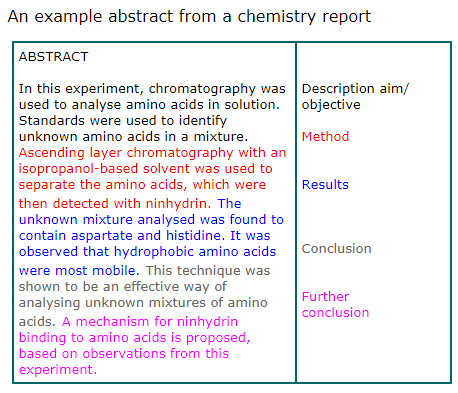
You put all this hard work into preparing your scientific paper.
But if you want your peers, colleagues, or students to read it, you need to put some more effort into crafting an effective abstract. Let’s find out how to do it.
What is a scientific abstract? A definition.
It’s a summary of a scientific paper, intended to summarize the research project, its purpose, achieved results, and conclusions. It gives a good idea of what’s inside the paper, but you have to read the whole thing. A more formal definition from Wikipedia: An abstract is a summary of a research article, thesis, review, conference proceeding, or any in-depth analysis of a particular subject and is often used to help the reader quickly find out the paper’s purpose.
A good abstract has the following qualities:
- 1. Summarize the findings in your paper
- 2. Persuades the reader to download and read the full article
- 3. If it’s prepared for a conference, it gets you selected for a talk and makes the audience curious about your subject
- 4. It presents the exact results of your research, not only a list of topics
- 5. It’s composed of an introduction, a body, and a conclusion
- 6. Usually, it’s no longer than 250 words (but may go up to 500), and it’s written in a 12-size font
- 7. It should be accessible to a general reader (you go into the nitty-gritty in the paper itself)
- 8. It communicates the main point of your research, why it matters, and what you concluded
- 9. If you co-authored the paper with someone else, you mention them in the abstract
- 10. If you’ve been mentored by any members of your faculty while doing research, you mention them as well
- 11. In it, you share the methods you used, and the results you achieved, and finish with a conclusion
“Somewhere, something incredible is waiting to be known.” – Carl Sagan
Types of abstracts for different uses:
- For an article in a scientific publication
- For a conference presentation (academic poster)
- Graphical abstract, video abstract (they include visuals but follow the same basic format shown below).
Here’s a simple example of an abstract:

Writing an abstract for an article in a scientific publication
Here are a couple of rules to follow if you’re preparing to submit your work for publication:
- The title of the paper should be clear but enticing
- The inclusion of data is acceptable (but only in summary)
- Try not to use citations or URLs in the abstract. Leave that for the paper itself
- Use clear language, don’t overcomplicate, and be straightforward
- Before submitting, give it one more final edit
- Check the spelling, grammar, and syntax. You can use Grammarly for that.
- After the title and the introduction, say why the reader should care about this research (motivation)
- Make sure you include the right keywords at the bottom of the abstract. They will make your paper more searchable in the science database, which makes it easier for it to get found and receive citations. Answer this question when thinking about keywords: what would someone type in the search engine to find your paper?
Follow a proven format:
- Authors
- Title
- The problem, challenge, or a question
- Why should you care
- Methods used
- Results achieved
- Conclusion and steps forward
- Keywords
- (Usually around 250 words)
Writing an abstract for a conference presentation (poster)
A good abstract can go a long way in advancing your scientific career. The organizers of the event will review it in every detail and select your article for a presentation based on its quality. It all depends on the caliber of the event, but for the well-attended ones, your abstract will make or break your chances of presenting to a big audience. People who approve articles for presentation want the audience to be engaged and will accept only the highest quality material.
Here are a few guidelines for preparing a solid conference abstract:
- People in the audience won’t have access to your full article, so you only have the abstract to present your research succinctly.
- Usually, there’s a strict limit of words you can use, so you need to plan how to pique the interest of the audience with a limited amount of space.
- The abstract is like a business card or a short persuasive letter that will determine if you get the spotlight or not. A perfect match of scientific understanding and persuasive skills is required.
- Ask about the exact format specifications and check examples of abstracts from previous years.
- Sometimes you’ll have to submit the abstract months before the actual event. You’ll still need to come up with something to make it sound interesting. And then make sure you send the updated version before the conference.
Here you can find six examples of scientific abstracts written for a presentation. And here you can find a great article, about abstracts for a presentation, written by a Ph.D. with a 90% acceptance rate. And if you need to create a poster out of your abstract, here’s a great guide you can check as well as some amazing examples.
Here’s another good example from humanities:
Pagel, J. F.; Vann, B. H. The effects of dreaming on awake behavior. Dreaming: Journal of the Association for the Study of Dreams. Vol 2(4)229-237, Dec 1992. Abstract: Reports of the incorporation of dream mentation into a spectrum of awake behaviors were obtained from a heterogeneous awake population group through the utilization of self-reporting questionnaires (N=265). Results were analyzed to determine associations between age, gender, race, and the dream use variables. Significantly higher dream use was found in females for a majority of behaviors, and a negative correlation was found between increasing age and all dream questions studied. No significant racial/ethnic variation was found in the responses of the sample. These findings suggest that such a sociological approach to the study of the effects of dream mentation on awake behavior can provide insight into the sleep/dream states. Keywords: dream; dream use; behavior; age; gender; race; sleep; questionnaire. Here are more examples of abstracts from the University of Wisconsin. And from another scientific paper about dreams (with the actual paper included below).
Conclusion
As you can see, writing a solid summary of your scientific paper is straightforward. I hope that now you have a better understanding of the process, and will accomplish great things in the scientific community. Next up, you may want to explore a list of the top educational book publishers.
Hey there, welcome to my blog! I'm a full-time entrepreneur building two companies, a digital marketer, and a content creator with 10+ years of experience. I started RafalReyzer.com to provide you with great tools and strategies you can use to become a proficient digital marketer and achieve freedom through online creativity. My site is a one-stop shop for digital marketers, and content enthusiasts who want to be independent, earn more money, and create beautiful things. Explore my journey here, and don't forget to get in touch if you need help with digital marketing.

